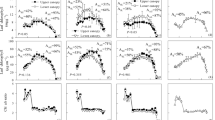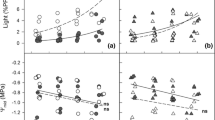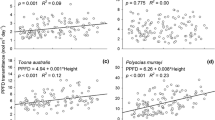Abstract
Key message
The relative shade tolerance of T. cordata , F. sylvatica , and C. betulus in mature stands is based on different species-specific carbon and nitrogen allocation patterns.
Abstract
The leaf morphology and photosynthetic capacity of trees are remarkably plastic in response to intra-canopy light gradients. While most studies examined seedlings, it is not well understood how plasticity differs in mature trees among species with contrasting shade tolerance. We studied light-saturated net photosynthesis (A max), maximum carboxylation rate (V cmax), electron transport capacity (J max) and leaf dark respiration (R d) along natural light gradients in the canopies of 26 adult trees of five broad-leaved tree species in a mixed temperate old-growth forest (Fraxinus excelsior, Acer pseudoplatanus, Carpinus betulus, Tilia cordata and Fagus sylvatica), representing a sequence from moderately light-demanding to highly shade-tolerant species. We searched for species differences in the dependence of photosynthetic capacity on relative irradiance (RI), specific leaf area (SLA) and nitrogen per leaf area (N a ). The three shade-tolerant species (C. betulus, T. cordata, F. sylvatica) differed from the two more light-demanding species by the formation of shade leaves with particularly high SLA but relatively low N a and consequently lower area-based A max, and a generally higher leaf morphological and functional plasticity across the canopy. Sun leaf morphology and physiology were more similar among the two groups. The three shade-tolerant species differed in their shade acclimation strategies which are primarily determined by the species’ plasticity in SLA. Under low light, T. cordata and F. sylvatica increased SLA, mass-based foliar N and leaf size, while C. betulus increased solely SLA exhibiting only low intra-crown plasticity in leaf morphology and N allocation patterns. This study with mature trees adds to our understanding of tree species differences in shade acclimation strategies under the natural conditions of a mixed old-growth forest.




Similar content being viewed by others
Abbreviations
- A max :
-
Light-saturated net photosynthesis rate under ambient CO2 concentration
- Ap:
-
Acer pseudoplatanus
- Cb:
-
Carpinus betulus
- C i :
-
Intercellular CO2 concentration
- DBH:
-
Diameter at breast height
- Fe:
-
Fraxinus excelsior
- Fs:
-
Fagus sylvatica
- J max :
-
Maximum electron transport rate
- N a :
-
Nitrogen per leaf area
- N m :
-
Nitrogen per leaf mass
- R d :
-
Leaf dark respiration rate calculated from the A/C i curve
- RI:
-
Relative irradiance
- SLA:
-
Specific leaf area (area per leaf mass)
- Tc:
-
Tilia cordata
- V cmax :
-
Maximum carboxylation rate
- VPD:
-
Atmospheric water vapour saturation deficit
- Suffix ‘a’:
-
Scaled to leaf area
- Suffix ‘m’:
-
Scaled to leaf mass
- Suffix ‘N’:
-
Scaled to leaf nitrogen
References
Abrams MD, Mostoller SA (1995) Gas-exchange, leaf structure and nitrogen in contrasting successional tree species growing in open and understory sites during a drought. Tree Physiol 15:361–370
Ball JT, Woodrow IE, Berry JA (1987) A model predicting stomatal conductance and its contribution to the control of photosynthesis under different environmental conditions. In: Biggins J (ed) Progress in photosynthesis research IV. Martinus Nijhof Publishers, Dordrecht, pp 221–234
Bazzaz FA (1979) The physiological ecology of plant succession. Annu Rev Ecol Syst 10:351–371
Bequet R, Kint V, Campioli M, Vansteenkiste D, Muys B, Ceulemans R (2012) Influence of stand, site and meteorological variables on the maximum leaf area index of beech, oak and Scots pine. Eur J For Res 131:283–295
Chaves MM, Pereira JS, Maroco J, Rodrigues ML, Ricardo CPP, Osorio ML, Carvalho I, Faria T, Pinheiro C (2002) How plants cope with water stress in the field. Photosynthesis and growth. Ann Bot 89:907–916
Ellenberg H, Leuschner C (2010) Vegetation Mitteleuropas mit den Alpen, 6th edn. Ulmer Verlag, Stuttgart
Ellsworth DS, Reich PB (1993) Canopy structure and vertical patterns of photosynthesis and related leaf traits in a deciduous forest. Oecologia 96:169–178
Farquhar GD, von Caemmerer S, Berry JA (1980) A biochemical model of photosynthetic CO2 assimilation in leaves of C3 species. Planta 149:78–90
Fay MP, Shaw PA (2010) Exact and asymptotic weighted logrank tests for interval censored data: the interval R package. J Stat Softw 36:1–34
Fender A-C, Mantilla-Contreras J, Leuschner C (2011) Multiple environmental control of leaf area and its significance for productivity in beech saplings. Trees-Struct Funct 25:847–857
Fleck S (2002) Integrated analysis of relationships between 3D-structure, leaf photosynthesis, and branch transpiration of mature Fagus sylvatica and Quercus petraea trees in a mixed forest stand. PhD thesis, University of Bayreuth, Bayreuth, Germany
Fleck S, Schmidt M, Köstner B, Faltin W, Tenhunen JD (2004) Impacts of canopy internal gradients on carbon and water exchange of beech trees. In: Matzner E (ed) “Biogeochemistry of forested catchments in a changing environment: a German case study”. Ecological Studies, vol 172. Springer Verlag, Heidelberg, pp 99–126
Frech A (2006) Walddynamik in Mischwäldern des Nationalparks Hainich - Untersuchung der Mechanismen und Prognose der Waldentwicklung. PhD thesis, University of Göttingen, Göttingen
Frech A, Leuschner C, Hagemeier M, Hölscher D (2003) Nachbarschaftsbezogene Analyse der Kronenraumbesetzung von Esche, Hainbuche und Winterlinde in einem artenreichen Laubmischwald (Nationalpark Hainich, Thueringen). Forstwissenschaftliches Centralblatt 122:22–35
Fricke-Beutnitz K (1904) “Licht- und Schattholzarten”, ein wissenschaftlich nicht begründetes Dogma. Centralblatt für das gesamte Forstwesen 30:315–325
Gebauer T, Horna V, Leuschner C (2008) Variability in radial sap flux density patterns and sapwood area among seven co-occurring temperate broad-leaved tree species. Tree Physiol 28:1821–1830
Givnish TJ (1988) Adaptation to sun and shade—a whole-plant perspective. Aust J Plant Physiol 15:63–92
Gries D (2004) Ökologische Grundlagen und biophysikalische Steuerung der Kohlenstoffbilanz zweier edaphisch gegensätzlicher Altbuchenbestände. Habilitation thesis, University of Göttingen, Göttingen, Germany
Hagemeier M (2002) Funktionale Kronenarchitektur mitteleuropäischer Baumarten am Beispiel von Hängebirke, Waldkiefer, Traubeneiche, Hainbuche, Winterlinde und Rotbuche. PhD Thesis, University of Göttingen, Göttingen, Germany
Hallé F, Oldeman RAA, Tomlinson PB (1978) Tropical trees and forests: an architectural analysis. Springer, Berlin
Harley PC, Tenhunen JD (1991) Modeling the photosynthetic response of C3 leaves to environmental factors. In: Boote KJ, Loomis RS (eds) Modeling crop photosynthesis -from biochemistry to canopy. American Society of Agronomy and Crop Science Society of America, Madison, pp 17–39
Hölscher D (2004) Leaf traits and photosynthetic parameters of saplings and adult trees of co-existing species in a temperate broad-leaved forest. Basic Appl Ecol 5:163–172
Köcher P, Gebauer T, Horna V, Leuschner C (2009) Leaf water status and stem xylem flux in relation to soil drought in five temperate broad-leaved tree species with contrasting water use strategies. Ann Forest Sci 66:101
Kull O, Niinemets U (1998) Distribution of leaf photosynthetic properties in tree canopies: comparison of species with different shade tolerance. Funct Ecol 12:472–479
Legner N, Fleck S, Leuschner C (2013) Low light acclimation in five temperate broadleaved tree species of different successional status: The significance of a shade canopy. Ann For Sci 70:557–570
Le Goff N, Granier A, Ottorini JM, Peiffer M (2004) Biomass increment and carbon balance of ash (Fraxinus excelsior) trees in an experimental stand in Northeastern France. Ann Forest Sci 61:577–588
Liburnau HL von (1918) Lehrbuch der Forstwirtschaft für Waldbau und Försterschulen Band 3, 4. Auflage, Verlag von W. Frick, Wien
Lichtenthaler HK, Buschmann C, Döll M, Fietz H-J, Bach T, Kozel U, Meier D, Rahmsdorf U (1981) Photosynthetic activity, chloroplast ultrastructure, and leaf characteristics of high-light and low-light plants and of sun and shade leaves. Photosynth Res 2:115–141
Meir P, Kruijt B, Broadmeadow M, Barbosa E, Kull O, Carswell F, Nobre A, Jarvis PG (2002) Acclimation of photosynthetic capacity to irradiance in tree canopies in relation to leaf nitrogen concentration and leaf mass per unit area. Plant Cell Environ 25:343–357
Monsi M, Saeki T (1953) Über den Lichtfaktor in den Pflanzengesellschaften und seine Bedeutung für die Stoffproduktion. Japanese J Bot 15:60–82
Niinemets U (1997) Role of foliar nitrogen in light harvesting and shade tolerance of four temperate deciduous woody species. Funct Ecol 11:518–531
Niinemets U (2007) Photosynthesis and resource distribution through plant canopies. Plant Cell Environ 30:1052–1071
Niinemets U (2010) A review of light interception in plant stands from leaf to canopy in different plant functional types and in species with varying shade tolerance. Ecol Res 25:693–714
Niinemets U, Fleck S (2002) Petiole mechanics, leaf inclination, morphology, and investment in support in relation to light availability in the canopy of Liriodendron tulipifera. Oecologia 132:21–33
Niinemets U, Valladares F (2006) Tolerance to shade, drought, and waterlogging of temperate northern hemisphere trees and shrubs. Ecol Monogr 76(4):521–547
Niinemets U, Kull O, Tenhunen JD (1998) An analysis of light effects on foliar morphology, physiology, and light interception in temperate deciduous woody species of contrasting shade tolerance. Tree Physiol 18:681–696
Niinemets U, Oja V, Kull O (1999) Shape of leaf photosynthetic electron transport versus temperature response curve is not constant along canopy light gradients in temperate deciduous trees. Plant Cell Environ 22:1497–1513
Niinemets U, Kull O, Tenhunen JD (2004) Within-canopy variation in the rate of development of photosynthetic capacity is proportional to integrated quantum flux density in temperate deciduous trees. Plant Cell Environ 27:293–313
Ogren E, Evans JR (1993) Photosynthetic light-response curves.1. The influence of CO2 partial-pressure and leaf inversion. Planta 189:182–190
Oguchi R, Hikosaka K, Hirose T (2005) Leaf anatomy as a constraint for photosynthetic acclimation: differential responses in leaf anatomy to increasing growth irradiance among three deciduous trees. Plant Cell Environ 28:916–927
Portsmuth A, Niinemets U (2007) Structural and physiological plasticity in response to light and nutrients in five temperate deciduous woody species of contrasting shade tolerance. Funct Ecol 21:61–77
R Development Core Team (2008) R: A language and environment for statistical computing. R Foundation for Statistical Computing, Vienna, Austria. http://www.R-project.org
Robakowski P, Wyka T, Samardakiewicz S, Kierzkowski D (2004) Growth, photosynthesis, and needle structure of silver fir (Abies alba Mill.) seedlings under different canopies. For Ecol Manag 201:211–227
Roderick ML (1999) Estimating the diffuse component from daily and monthly measurements of global radiation. Agric For Meteorol 95:169–185
Rozendaal DMA, Hurtado VH, Poorter L (2006) Plasticity in leaf traits of 38 tropical tree species in response to light; relationships with light demand and adult stature. Funct Ecol 20:207–216
Sack L, Melcher PJ, Liu WH, Middleton E, Pardee T (2006) How strong is intracanopy leaf plasticity in temperate deciduous trees? Am J Bot 93:829–839
Strauss-Debenedetti S, Bazzaz FA (1996) Photosynthetic characteristics of tropical trees along successional gradients. In: Mulkey SS, Chazdon RL, Smith AP (eds) Tropical forest plant ecophysiology. Chapmann & Hall, New York, pp 162–186
Thomas SC (2010) Photosynthetic capacity peaks at intermediate size in temperate deciduous trees. Tree Physiol 30:555–573
Thornley JHM (2002) Instantaneous canopy photosynthesis: analytical expressions for sun and shade leaves based on exponential light decay down the canopy and an acclimated non-rectangular hyperbola for leaf photosynthesis. Ann Bot 89:451–458
Tognetti R, Johnson JD, Michelozzi M (1997) Ecophysiological responses of Fagus sylvatica seedlings to changing light conditions.1. Interactions between photosynthetic acclimation and photoinhibition during simulated canopy gap formation. Physiol Plant 101:115–123
Urban O, Kosvancova M, Marek MV, Lichtenthaler HK (2007) Induction of photosynthesis and importance of limitations during the induction phase in sun and shade leaves of five ecologically contrasting tree species from the temperate zone. Tree Physiol 27:1207–1215
Valladares F, Niinemets U (2008) Shade tolerance, a key plant feature of complex nature and consequences. Annu Rev Ecol Evol Syst 39:237–257
Valladares F, Chico JM, Aranda I, Balaguer L, Dizengremel P, Manrique E, Dreyer E (2002) The greater seedling high-light tolerance of Quercus robur over Fagus sylvatica is linked to a greater physiological plasticity. Trees-Struct Funct 16:395–403
Walter JMN, Torquebiau EF (1997) The geometry of the canopy of a dipterocarp rain forest in Sumatra. Agric For Meteorol 85:99–115
Acknowledgments
The authors thank Deutsche Forschungsgemeinschaft (DFG) for financially supporting the study through ‘Graduiertenkolleg 1086: The role of biodiversity for biogeochemical cycles and biotic interactions in temperate deciduous forest’. We also thank Dirk Deilke and Ulrich Werder (Goettingen Experimental Botanical Garden) and the student helpers for their support in operating the mobile lift in the forest. We thank the administration of Hainich National Park (especially Jens Wilhelm) for manifold support and granting access to the forest and Paul Köcher for good cooperation in the field.
Author information
Authors and Affiliations
Corresponding author
Additional information
Communicated by A. Gessler.
Rights and permissions
About this article
Cite this article
Legner, N., Fleck, S. & Leuschner, C. Within-canopy variation in photosynthetic capacity, SLA and foliar N in temperate broad-leaved trees with contrasting shade tolerance. Trees 28, 263–280 (2014). https://doi.org/10.1007/s00468-013-0947-0
Received:
Revised:
Accepted:
Published:
Issue Date:
DOI: https://doi.org/10.1007/s00468-013-0947-0




